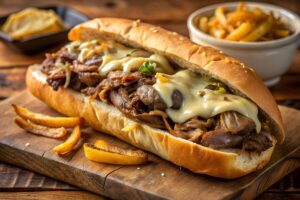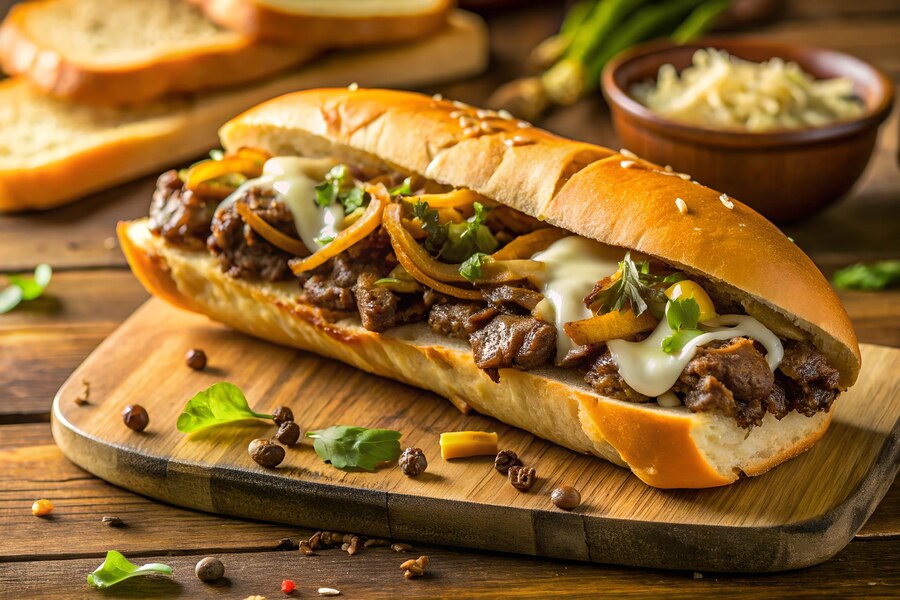The Philly cheese steak is one of America’s most beloved sandwiches, rooted in the rich culinary history of Philadelphia. Its mouthwatering combination of thinly sliced beef, melted cheese, and a soft hoagie roll makes it a classic comfort food that people can’t get enough of. But have you ever wondered what meat is used to craft the perfect Philly cheesesteak? If you’re a food enthusiast or someone looking to make an authentic cheesesteak at home, understanding the meat choices is crucial.
In this guide, we will dive deep into the best meat for a Philly cheesesteak, explore alternatives, and cover everything from cheese options to cooking techniques, all while offering expert tips on how to build the ultimate sandwich. Whether you’re a Philly native or just love this iconic sandwich, you’ll find everything you need to know here.
The History of the Philly Cheesesteak: A Legendary Sandwich
The story of the Philly cheesesteak dates back to the early 20th century. Pat Olivieri, a hot dog vendor in Philadelphia, is credited with creating the first cheesesteak. One day in the 1930s, he decided to cook up some sliced beef on his grill and served it in a hoagie roll. This simple sandwich quickly became a hit, leading him to open “Pat’s King of Steaks,” one of the most famous cheesesteak shops in Philadelphia.
At first, the sandwich didn’t include cheese, but eventually, cheese was added to create the cheesesteak we know and love today. Cheese Whiz became the standard, though other options like provolone and American cheese are now just as popular.
Choosing the Best Meat for a Philly Cheesesteak
When it comes to making an authentic Philly cheesesteak, the quality and type of meat are essential. The traditional meat used for a Philly cheesesteak is ribeye steak. This cut of beef is known for its perfect balance of tenderness and flavor due to its marbling (the fat that runs through the meat). The fat melts during cooking, creating a juicy and flavorful sandwich that is hard to beat.
Why Ribeye Steak?
- Marbling: The fat content in ribeye makes it incredibly juicy.
- Flavor: The ribeye has a rich, beefy flavor that’s hard to match.
- Tenderness: When sliced thinly, ribeye is tender and easy to chew, a key characteristic of a good cheesesteak.
To prepare the ribeye for a cheesesteak, the steak is typically frozen slightly before being thinly sliced. This ensures even, quick cooking and the right texture for the sandwich.
Tip: If you’re making a Philly cheesesteak at home, freeze your ribeye for about 20-30 minutes before slicing. This makes it much easier to get those ultra-thin slices.
Alternative Meats for a Philly Cheese steak
Although ribeye is the gold standard, there are other cuts of beef that can be used if you’re looking for a different flavor profile or a more budget-friendly option. Here are some alternatives:
- Sirloin Steak
- Flavor: Sirloin is leaner than ribeye but still has enough flavor to make a good cheesesteak.
- Tenderness: It’s slightly less tender than ribeye, but thinly slicing it helps prevent toughness.
- Recommendation: If you’re opting for sirloin, consider marinating it to enhance its flavor.
- Flank Steak
- Flavor: Flank steak is a bit tougher and leaner than ribeye, but it can work for a cheesesteak if it’s sliced very thin.
- Cooking: Flank steak can be grilled or pan-fried, but it requires careful slicing against the grain to avoid a chewy texture.
- Chuck Roast
- Flavor: Chuck roast is a rich, flavorful cut often used for slow-cooking.
- Cooking Method: Slow-cooked chuck roast can be shredded for a different take on the cheesesteak. Though not traditional, this approach is tasty and makes for a unique version of the sandwich.
- Skirt Steak
- Flavor: Skirt steak offers a bold flavor, but it can be tough if not prepared properly.
- Preparation: Like flank steak, skirt steak needs to be sliced thinly and against the grain for the best texture.
While these alternative cuts can work in a cheesesteak, ribeye remains the top choice for an authentic Philly experience.
Sourcing High-Quality Meat for the Ultimate Philly Cheese steak

When it comes to making a cheesesteak that rivals those found at famous Philadelphia shops, sourcing the right meat is just as important as choosing the right cut. Here are some tips for finding the best quality beef for your cheesesteak:
- Look for Marbling
- Whether you’re buying ribeye or another cut, marbling is key. The fat in the beef will melt as it cooks, ensuring the meat stays juicy and flavorful.
- Grass-Fed vs. Grain-Fed Beef
- Grass-fed beef tends to be leaner with a slightly different flavor profile. If you prefer a cleaner, more robust taste, this is a good option.
- Grain-fed beef is fattier and often considered more tender due to the higher marbling content.
- Local Sourcing vs. Supermarket Beef
- If possible, visit a local butcher for the freshest and highest-quality cuts. Butchers can provide custom slices for your cheesesteak, ensuring the meat is perfectly prepped.
Cooking Techniques: The Secret to a Perfect Cheese steak
The right cooking technique is just as important as the type of meat. For the best results, the beef should be cooked quickly at high heat to achieve a perfect sear without overcooking. Here’s how to get it right:
- Slicing the Meat Thin
- The thinner the slice, the better. Thinly sliced beef ensures the meat cooks quickly and retains its tenderness. Slightly freezing the meat before slicing can make this step much easier.
- Cooking on a Griddle or Cast-Iron Skillet
- The traditional method for cooking Philly cheese steak meat is on a griddle. The high heat of the griddle allows for a fast sear, which locks in the flavor.
- At home, you can replicate this with a cast-iron skillet. Heat the skillet on high, add a little oil, and quickly sear the sliced meat.
- Avoid Overcooking
- Philly cheese steak meat should only be cooked for a minute or two on each side. Overcooking will dry out the beef, resulting in a tough sandwich.
For more ideas on how to experiment with different ingredients, you can explore this guide on seasoning steak for various dishes.
Cheese Options for the Philly Cheese steak: What’s Best?
No cheesesteak is complete without the right cheese. While there’s some debate over which cheese is the best, the three most popular choices are:
- Cheese Whiz
- This processed cheese sauce is a staple in many authentic Philly cheesesteaks. Its gooey texture and strong flavor make it a favorite for purists.
- Tip: If you’re going for an authentic Philly experience, Cheese Whiz is a must-try.
- Provolone Cheese
- A slightly sharper option, provolone offers a creamy, smooth melt. It’s often the choice for those who prefer a more traditional cheese with a less processed flavor.
- Tip: Mild provolone is best for cheesesteaks, as sharp provolone can overpower the sandwich’s flavor.
- American Cheese
- Known for its meltability, American cheese provides a milder, creamier taste. It’s an excellent middle ground between Cheese Whiz and provolone.
- Tip: Layer the American cheese directly on the hot meat, allowing it to melt and combine with the steak.
The Role of Toppings: Elevating Your Philly Cheese steak
While a traditional Philly cheese steak consists of just meat and cheese, many people enjoy adding extra toppings. The most common toppings include:
- Caramelized Onions
- Onions are often cooked alongside the meat, adding a sweet, savory flavor to the sandwich.
- Tip: Caramelize the onions by cooking them slowly over medium heat until they turn golden brown.
- Bell Peppers
- Adding green, red, or yellow bell peppers gives the sandwich a pop of color and a slight sweetness.
- Tip: Sauté the peppers until soft, then add them to the sandwich for extra texture and flavor.
- Mushrooms
- Some variations of the cheesesteak include sautéed mushrooms, which add a rich, earthy flavor.
- Tip: Cook the mushrooms until they release their moisture and become golden brown.
Building the Perfect Philly Cheese steak at Home
Now that you know the basics of the meat, cheese, and toppings, it’s time to build the perfect Philly cheesesteak at home. Follow these steps for the ultimate sandwich experience:
- Choose the Right Roll
- The bread is just as important as the meat and cheese. A hoagie roll is the traditional choice. It should be soft enough to soak up the juices from the meat but sturdy enough to hold all the ingredients without falling apart.
- Tip: Toast the roll lightly for added texture.
- Cook the Meat and Onions Together
- Start by cooking the onions first until they caramelize. Then, add the thinly sliced ribeye to the same pan or griddle. This allows the flavors to meld together.
- Tip: Don’t overcook the meat—just a quick sear on high heat will do the trick.
- Add Cheese and Melt
- Once the meat is cooked, add your cheese of choice directly on top of the meat. Cover the pan briefly to let the cheese melt.
- Tip: If using Cheese Whiz, spread it onto the roll before adding the meat for even coverage.
- Assemble the Sandwich
- Layer the meat, cheese, and any toppings onto the hoagie roll. Serve immediately for the best experience.
- Tip: Serve your cheesesteak with a side of fries or chips for a complete meal.
FAQs About Philly Cheesesteak
What is the most authentic meat for a Philly cheese steak?
Ribeye steak is the most authentic and traditional choice for a Philly cheesesteak due to its tenderness and rich flavor.
Can I use ground beef meat for a Philly cheese steak?
While ground beef can be used as a budget-friendly alternative, it lacks the texture and flavor of thinly sliced ribeye or sirloin. Ground beef doesn’t provide the same authentic cheesesteak experience.
What is the difference between a Philly cheese steak and a regular steak sandwich?
A Philly cheesesteak uses thinly sliced ribeye steak, cheese, and sometimes caramelized onions, all served on a hoagie roll. A regular steak sandwich can vary significantly in terms of meat, bread, and toppings.
Which cheese is the best for a Philly cheesesteak?
The most common choices are Cheese Whiz, provolone, and American cheese. The best option depends on your personal taste.
Where to Find the Best Philly Cheese steaks ?
If you’re ever in Philadelphia, visiting the city’s famous cheesesteak shops is a must. Some of the top places to get an authentic Philly cheesesteak include:
- Pat’s King of Steaks: Where it all began.
- Geno’s Steaks: Pat’s rival and another classic spot.
- Jim’s Steaks: Known for its flavorful sandwiches and old-school vibe.
Not in Philly? No worries! You can still enjoy a homemade version by following the tips and tricks outlined in this guide.
Conclusion
Crafting the perfect Philly cheese steak is all about using the right meat and mastering the cooking technique. Whether you stick with the traditional ribeye steak and Cheese Whiz or opt for your favorite alternatives, this guide will help you create a sandwich that’s bursting with flavor.
By paying attention to the type of meat, the quality of the cheese, and the cooking method, you’ll be able to replicate the magic of this iconic sandwich in your own kitchen. Now that you know what meat is used for a Philly cheesesteak, it’s time to roll up your sleeves and get cooking!

